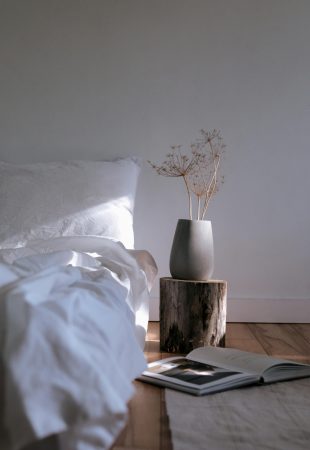Japandi is a hybrid interior trend that blends Japanese minimalism with Scandinavian functionality. The result is a clean, warm aesthetic that celebrates simplicity, craftsmanship, and natural materials. With its origins dating back to around 2016, the style continues to thrive in 2025, offering a calming antidote to overly busy or decorative interiors.
ALSO SEE: How to merge two décor styles for a cohesive home
At the heart of Japandi lies a philosophical overlap between two distinct cultures. The Japanese principle of wabi-sabi, which finds beauty in imperfection and impermanence, meets hygge, the Scandinavian idea of comfort and cosiness. Together, they create a style that prioritises practicality, serenity, and balance, without compromising on visual appeal.
Muted colours and natural materials
A Japandi space typically begins with a neutral foundation. Walls, floors, and large furniture pieces are kept in shades of beige, taupe, off-white, and soft greys, often with warm undertones. These colours act as a soothing canvas for natural textures such as oak, ash, rattan, linen, and stone.

Pexels
Wood plays a central role in Japandi interiors, lending warmth and tactility. The tone of the wood matters—lighter shades bring airiness, while darker hues add grounding depth. These materials can be layered thoughtfully through cabinetry, flooring, and small accent pieces for visual interest.
Simplicity with substance
Japandi’s guiding principle is intentionality. Every item has a purpose, whether it is functional, decorative, or both. Clutter is kept to a minimum, with a focus on hidden storage and multi-use furnishings. Open shelving, if used, is curated with restraint—think a few handmade ceramics or a single vase of dried foliage.
Furniture is low-slung and unfussy, often featuring clean lines and natural finishes. Pieces are chosen for their longevity and craftsmanship rather than trend-led appeal. Decorative elements are minimal, and ornaments tend to have raw or organic textures to echo the theme of natural imperfection.
Lighting as mood, not just function
Lighting is a vital but often overlooked aspect of Japandi décor. In this style, it goes beyond function to shape atmosphere. Instead of harsh overhead lights, a layered approach is preferred—soft pendant lights, table lamps, or wall sconces with linen or wooden finishes help create a cocooning, ambient glow.
This approach is especially effective in kitchens and open-plan living areas, where task lighting can be paired with warmer, dimmer options to transition between practical use and relaxed ambiance.
Bringing nature indoors
Connection to nature is key in Japandi design. Houseplants, whether leafy and lush or pared-back and sculptural, are used to soften interiors and enhance a sense of well-being. Popular choices include snake plants, aloe vera, or trailing ivy. Dried arrangements such as pampas grass or eucalyptus offer an alternative that requires little maintenance but still ties in with the natural aesthetic.

Pexels
Window dressings also play a part. Curtains or blinds made from natural fabrics like linen or bamboo can add texture and softness while reinforcing the indoor-outdoor harmony central to Japandi.
Decluttered living and hidden storage
Storage is essential to achieving Japandi’s minimalist look. Clutter-free surfaces and clean lines depend on smart solutions, such as concealed cupboards, built-in shelves, or freestanding sideboards. In kitchens, an ‘invisible’ look can be achieved by integrating appliances and hiding smaller items behind cabinetry.
Organised storage systems help maintain the aesthetic long term. Grouping similar items and keeping only essentials in view allows the space to breathe and remain functional.
Layered textures for warmth
Although minimal, Japandi interiors never feel cold. Layering is used to bring warmth and visual softness. This might be seen in the combination of textured cushions, natural-fibre rugs, or lightly crinkled linens in a muted palette. Tableware and decorative objects also contribute, often chosen for their handmade feel—unglazed ceramics, reeded glass, and organic shapes are key choices.
Rather than symmetry or perfection, the focus is on harmony. Every element contributes to a sense of calm and cohesion.
A timeless trend rooted in mindfulness
Japandi décor is more than a style—it’s a lifestyle shift towards mindful consumption, quiet beauty, and lasting quality. As homes increasingly become sanctuaries for rest and reflection, this design philosophy offers both a visual and emotional refuge.
With a few thoughtful changes—decluttering, layering textures, introducing natural elements, and focusing on quality over quantity—it is possible to bring the essence of Japandi into any space, regardless of size or budget.
ALSO SEE:
Timeless interior decorating tips we should steal from our parents and grandparents
Featured Image: Pexels

